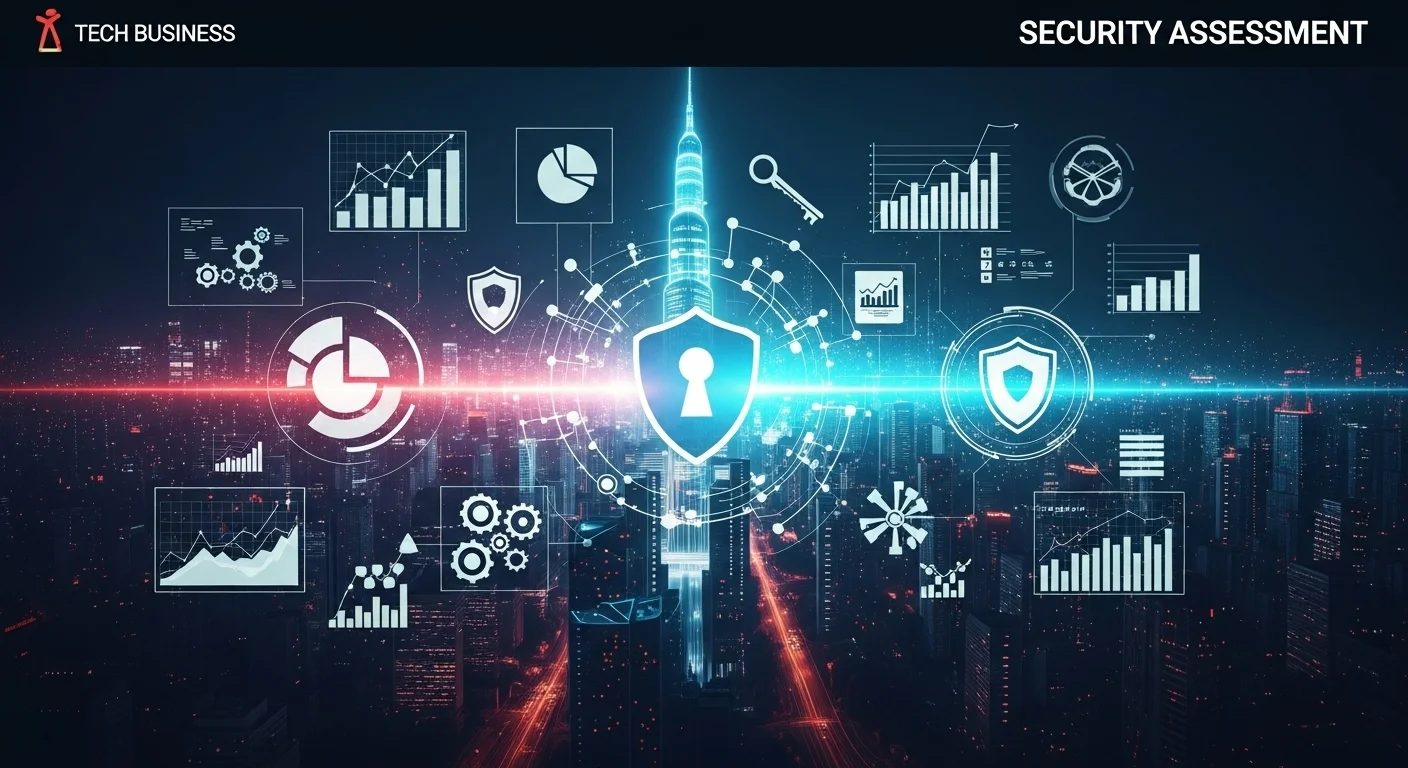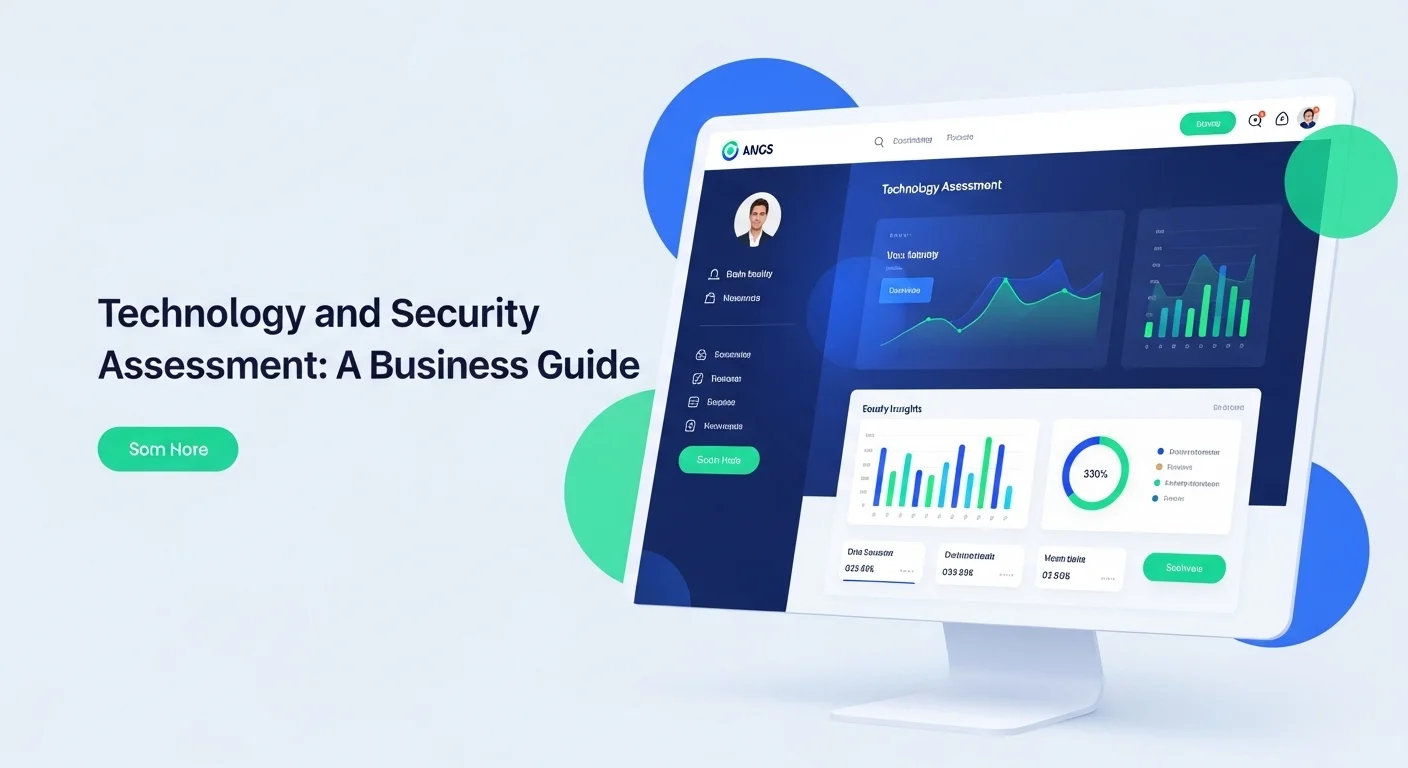What is a Security Assessment? A Plain-English Guide for Your Business

Executive Summary
In today's fast-paced digital world, thinking about cybersecurity can feel overwhelming. But let's simplify it. A security assessment isn't just for giant corporations; it's a crucial health check for any business that uses technology. I've been in this field for over a decade, and I've seen firsthand how a simple check-up can prevent a major catastrophe. This article is your straightforward guide to understanding what a security assessment really is. We'll walk through the different kinds, like checking your network or your information handling processes, and explain why they are so important. Think of this as your first line of defense against cyber threats, helping you protect your data, comply with regulations, and earn the trust of your clients. By the end, you'll have the confidence and knowledge to make smart decisions about your company's security.
Table of Contents
Table of Contents
- What is a Security Assessment and Why Does It Matter?
- A Closer Look at Different Assessment Types
- The Real-World Benefits for Your Business
- A Practical Guide to Security Assessments
- The Security Assessment Process, Step by Step
- Expert Tips to Improve Your Security Experience
- Why You Should Adopt a Continuous Assessment Model
What is a Security Assessment and Why Does It Matter?
In my years as a security strategist, I’ve learned that the best defense is a good offense. That's exactly what a security assessment is: a proactive, organized look at your organization's security to find weak spots before the bad guys do. It’s not about pointing fingers; it’s a smart process designed to reveal vulnerabilities so you can fix them. This isn't a one-and-done task. Technology and threats are always changing, so think of it as a continuous health check for your digital operations. The main goal is simple: to give you a clear, honest picture of your security risks. This allows you, as a business leader, to make informed decisions about where to invest your time and money to build the strongest defense possible. Flying blind with security is a risk no one can afford to take.
The importance of this process in today's tech-driven world is immense. Nearly every business, big or small, depends on a complex web of technology—from cloud services and websites to internal networks. Each piece is a potential door for an attacker. A data breach can be devastating, leading to huge financial losses, a damaged reputation, and broken customer trust. I've seen companies struggle to recover from breaches that could have been easily prevented. Regular security assessments are your best bet to avoid these disasters by catching issues early. On top of that, many industries have strict data protection rules like GDPR or HIPAA. Performing regular assessments is often a legal requirement, helping you steer clear of massive fines and legal trouble.
A Closer Look at Different Assessment Types
Security assessments aren't one-size-fits-all. They come in different flavors, each designed to check a specific part of your tech setup. Knowing the difference helps you build a truly solid security plan. A great place to start is with an information security assessment. This is a broad review of your policies and procedures for protecting data. It looks at how you handle information from the moment it's created to when it's deleted, making sure it stays confidential and available. Many businesses align this with frameworks like ISO 27001, which is a globally recognized standard for managing information securely.
Next up is the network security assessment. As the name suggests, this focuses squarely on your network infrastructure—your firewalls, routers, Wi-Fi, and all connected devices. The goal here is to find and fix any holes that could let an unauthorized person in, whether they're outside the company or already on the inside. We often use techniques like network scanning to see what's running and even simulate attacks to test the defenses. Keeping your network secure is fundamental to preventing data theft and ensuring your business stays online.
From there, we get more specific with an information security risk assessment. This process is a game-changer because it doesn't just list vulnerabilities; it helps you understand the *real* risk. It asks: what’s the likelihood of this weakness being exploited, and what would be the damage to our business? This risk-based approach is at the heart of modern cybersecurity. It helps you create a prioritized to-do list, so you can focus your budget and energy on fixing the biggest threats first. It’s all about making smart, strategic investments in your security.
Similarly, a network security risk assessment applies this same thinking specifically to your network. It evaluates threats to your network gear and the potential business impact. For example, what's the risk of an attack taking down your website, and what would that cost you in sales and reputation? A good assessment here connects the technical dots to the business bottom line, ensuring your protective measures match the value of what you're protecting.
Finally, in an age where your website is often your storefront, a web security assessment is non-negotiable. This review focuses on finding flaws in your web applications. I’ve seen countless attacks that exploit common issues like SQL injection or cross-site scripting (XSS), which are tracked by organizations like OWASP (the Open Web Application Security Project). This assessment uses a mix of automated tools and manual, human-led testing to uncover these weak spots. Since your website is a prime target for attackers, keeping it locked down is vital for protecting your data and maintaining your customers' confidence.
The Real-World Benefits for Your Business
The practical applications of security assessments are huge. For a small business with a tight budget, an assessment provides a clear, affordable roadmap to better security. It helps you focus on what truly matters. For a large corporation, regular assessments are essential to manage a complex IT world, stay compliant with various laws, and protect a global brand.
But the benefits go way beyond finding flaws. One of the biggest wins is cost savings. Let me be clear: fixing a security hole is far cheaper than cleaning up after a data breach. The costs of a breach—from incident response and fines to lawsuits and notifying customers—can be staggering. Being proactive saves a massive amount of money and headaches down the road.
Another key benefit is a more resilient business. When you understand your weaknesses, you can build better plans for when things go wrong. This preparation means that if an incident does happen, you can respond quickly, minimizing downtime and disruption. It also helps create a security-conscious culture where everyone in the company plays a role in staying safe. This shift in mindset is one of the most powerful defenses you can have.
Finally, showing your commitment to security can be a powerful competitive advantage. It builds incredible trust with customers, partners, and investors. In a crowded market, knowing that you take security seriously can be the very reason a client chooses you over a competitor. That trust is an invaluable asset for long-term growth.

A Practical Guide to Security Assessments in Technology and Business
Starting a security assessment can feel like a big project, but with the right approach, it's a manageable and incredibly valuable process. It’s more than just running some software; it’s a structured journey that gives you a complete picture of your security. In all my projects, success comes from following a clear roadmap. This guide will walk you through the methods and techniques that form the foundation of a strong security assessment, giving you the blueprint you need.
Choosing Your Framework: The Foundation of a Good Assessment
Before you dive into the technical work, it's wise to ground your assessment in a recognized framework. Think of these as proven recipes for success. They provide a structured approach, ensuring your assessment is thorough, consistent, and follows industry best practices. Two of the most respected are the NIST Cybersecurity Framework (CSF) and ISO/IEC 27001.
The NIST Cybersecurity Framework is a fantastic, flexible guide for managing cybersecurity risk. It’s organized around five simple functions: Identify, Protect, Detect, Respond, and Recover. I find it’s especially helpful for organizations looking to build or improve their security program because it provides a common language for everyone to use. An assessment based on NIST helps you see where you’re strong and where you have gaps across these key areas.
On the other hand, ISO/IEC 27001 is a more formal and detailed standard for creating an Information Security Management System (ISMS). Getting ISO 27001 certified is a big deal; it involves a tough audit and proves to the world that you have a top-tier security program. An information security assessment under ISO 27001 includes a very detailed information security risk assessment to determine which security controls are necessary. It's an international gold standard, often expected when you're working with global partners.
Don't forget other great resources, like the OWASP Top Ten list for any web security assessment—it’s my go-to for prioritizing web application risks. The CIS Controls are also excellent for a prioritized list of actions against common attacks. The right choice depends on your industry, size, and security goals.
The Security Assessment Process: A Step-by-Step Approach
No matter which framework you use, the assessment process generally follows a logical path. I've guided countless teams through these steps, and they are key to an effective evaluation.
Step 1: Scoping and Planning. This is the most important step. Before you do anything, you must define what you're assessing. Which systems, applications, or networks are in scope? What are you trying to achieve? This is where you talk to stakeholders, understand legal requirements, and set the rules, especially for more hands-on tests. A clear scope is your best friend—it prevents the project from spiraling out of control and keeps the focus on your most critical assets.
Step 2: Information Gathering. Once the scope is set, it's time for detective work. The goal is to learn as much as possible about the target environment. This means creating a list of all your hardware, software, and data. For a network security assessment, this involves mapping the network and scanning for open ports to see what's visible. This foundational knowledge is crucial for the analysis to come.
Step 3: Finding and Analyzing Vulnerabilities. This is where the real technical magic happens. We use various tools and techniques to find security weaknesses. This includes:
- Vulnerability Scanning: We use automated tools like Nessus or OpenVAS to scan for thousands of known vulnerabilities, like outdated software or bad configurations. It's a fast and efficient way to get a wide view of your security.
- Penetration Testing (Ethical Hacking): This is where a human expert, an ethical hacker, tries to break in just like a real attacker would. We use tools like Metasploit to see if a vulnerability can actually be exploited. This is a vital part of any serious network security risk assessment or web security assessment because it shows the real-world impact of a flaw.
- Configuration Review: This involves checking the settings on your servers, firewalls, and other devices against security best practices to spot any gaps.
Step 4: Risk Analysis and Prioritization. After finding vulnerabilities, we figure out how risky they really are. This is the core of an information security risk assessment. For each issue, we ask: how likely is an attack, and how bad would it be for the business? This gives each vulnerability a rating (like Critical, High, or Medium), so you know what to fix first. This step is all about focusing your resources where they will have the most impact.
Step 5: Reporting and Communication. The findings have to be presented in a clear, actionable report. I always create two parts: an executive summary for leaders that explains the risks in business terms, and a detailed technical section for IT teams with step-by-step instructions on how to fix things. The report must provide concrete, prioritized recommendations.
Step 6: Fixing and Verifying. The final, and most satisfying, step is to act on the report. Your teams follow a plan to fix the identified vulnerabilities. Afterward, it's crucial to run another scan or test to make sure the fixes worked and didn't accidentally create new problems. This closes the loop and confirms your security has improved.
Automated Tools vs. Human Experts
It's important to understand the difference between automated scanning and manual testing. Automated scanners are great for covering a lot of ground quickly, but they can miss things and sometimes give false alarms. A skilled human tester, however, brings creativity and intuition. An expert can find complex flaws in business logic and show the true impact in a way a tool can't. In my experience, the best information security assessment always combines the speed of automation with the depth of manual expertise. This combination gives you the most complete and accurate picture of your security.

Expert Tips and Strategies to Improve Your Security Experience
Getting the most out of your security assessments isn't just about the technology; it's about having the right strategy and always looking to improve. For any business or tech professional, the goal should be to move from just 'checking the box' for compliance to building a proactive culture of security. Here are some of my go-to tips, strategies, and best practices to enhance your assessments and improve your overall security posture.
Embracing a Continuous Assessment Model
One of the biggest strategic shifts I recommend to clients is moving from a once-a-year assessment to a continuous model. The digital world doesn't stand still—new threats emerge every day and your systems are constantly changing. An annual assessment report can be outdated the day after it’s printed, leaving you vulnerable.
Strategy 1: Automate and Integrate Your Scans. Use automation to your advantage. Set up automated vulnerability scanners to run regularly—weekly or even daily—across your systems. A pro tip is to integrate these security scans directly into your development process. This is often called DevSecOps, and it means security is baked in from the very beginning, not bolted on at the end. It's a must-do for any modern web security assessment program.
Strategy 2: Build a Solid Vulnerability Management Program. A continuous assessment model is the backbone of a strong vulnerability management program. This program should define the entire lifecycle for every vulnerability you find. Key parts include:
- Clear Roles and Responsibilities: Everyone should know who's responsible for tracking issues, assigning fixes, and confirming they're resolved.
- Firm Deadlines (SLAs): Set clear timelines for fixing vulnerabilities based on how severe they are. For example, critical issues must be patched in 15 days, high-priority ones in 30, and so on.
- Track Everything: Use a central system to monitor the status of all vulnerabilities and provide regular reports to leadership on your progress and overall risk level.
Best Practices for a High-Impact Assessment
To make sure your assessments are worth the effort, follow these best practices I've honed over the years:
Tip 1: Think Like an Attacker. A great assessment, especially a penetration test, requires you to get into an adversarial mindset. Don't just follow a checklist. Think creatively about how different small weaknesses could be combined to pull off a major attack. When doing a network security risk assessment, consider all angles, including tricking employees (phishing), physical security, and even risks from your suppliers. This 360-degree view gives you a much more realistic picture of your true risk.
Tip 2: Prioritize with Business Context. A technical score for a vulnerability is just a number. The real risk depends on what that system does for your business. A medium-level flaw on a server holding all your customer data is a much bigger deal than a critical flaw on an isolated test machine. An effective information security risk assessment must always factor in the business impact to ensure you’re fixing what matters most.
Tip 3: Don't Forget the Human Factor. Technology is only one piece of the puzzle. I've seen many successful hacks that exploited people, not code. Your assessment strategy must include testing your team. Run regular phishing simulations to see how aware your employees are and provide training where it's needed. A complete information security assessment always looks at people, processes, and technology together.
Leveraging Tools and Outside Help
You don't have to do this all by yourself. There's a whole world of tools out there to help. Commercial tools like Nessus and Qualys are powerhouses for vulnerability scanning. For hands-on penetration testing, frameworks like Metasploit and tools like Burp Suite are the industry standard. There are even platforms to help you manage the entire information security risk assessment process.
Beyond tools, consider bringing in outside experts. Hiring a good third-party firm for an annual penetration test gives you a fresh, unbiased pair of eyes. They bring a wealth of experience from different industries that your internal team might not have. This external validation is often required for compliance and gives your leadership great peace of mind.
For staying up-to-date, I always point people to incredible free resources. A favorite of mine is the OWASP (Open Web Application Security Project) website. It's a treasure trove for anyone involved in web security, with guides, cheat sheets, and the famous OWASP Top Ten list. Staying engaged with resources like these is essential for anyone responsible for a web security assessment.
Improving Your Technology Experience Through Security
At the end of the day, a security assessment isn't about finding flaws; it's about enabling your business to use technology with confidence. When security is woven into your operations, it stops being a barrier and starts being a driver of innovation. A strong security posture lets you adopt new technologies like the cloud or AI without fear because you know the risks are managed. It improves the experience for your customers, who trust you with their data, and for your employees, who get to work in a secure and stable environment.
By taking a strategic, continuous, and risk-based approach to security assessment, you can fundamentally change your relationship with security. It becomes less about a technical checklist and more about building a resilient, trustworthy business. The insights from a well-run network security assessment or information security assessment will empower you to make smarter decisions, spend your budget wisely, and foster a culture of security that protects you from the inside out.
Expert Reviews & Testimonials
Sarah Johnson, Business Owner ⭐⭐⭐
This is solid information on Security Assessments, but as a business owner, I'd have loved to see more real-world examples I could apply directly to my small shop.
Mike Chen, IT Consultant ⭐⭐⭐⭐
A really useful article on Security Assessment. It helped clarify the whole process for me, though a few of the more technical concepts could be broken down even further for newcomers.
Emma Davis, Tech Expert ⭐⭐⭐⭐⭐
Excellent article! This is a very comprehensive and well-explained guide to Security Assessment. It was perfect for my specialization studies, and I understood every part clearly.



